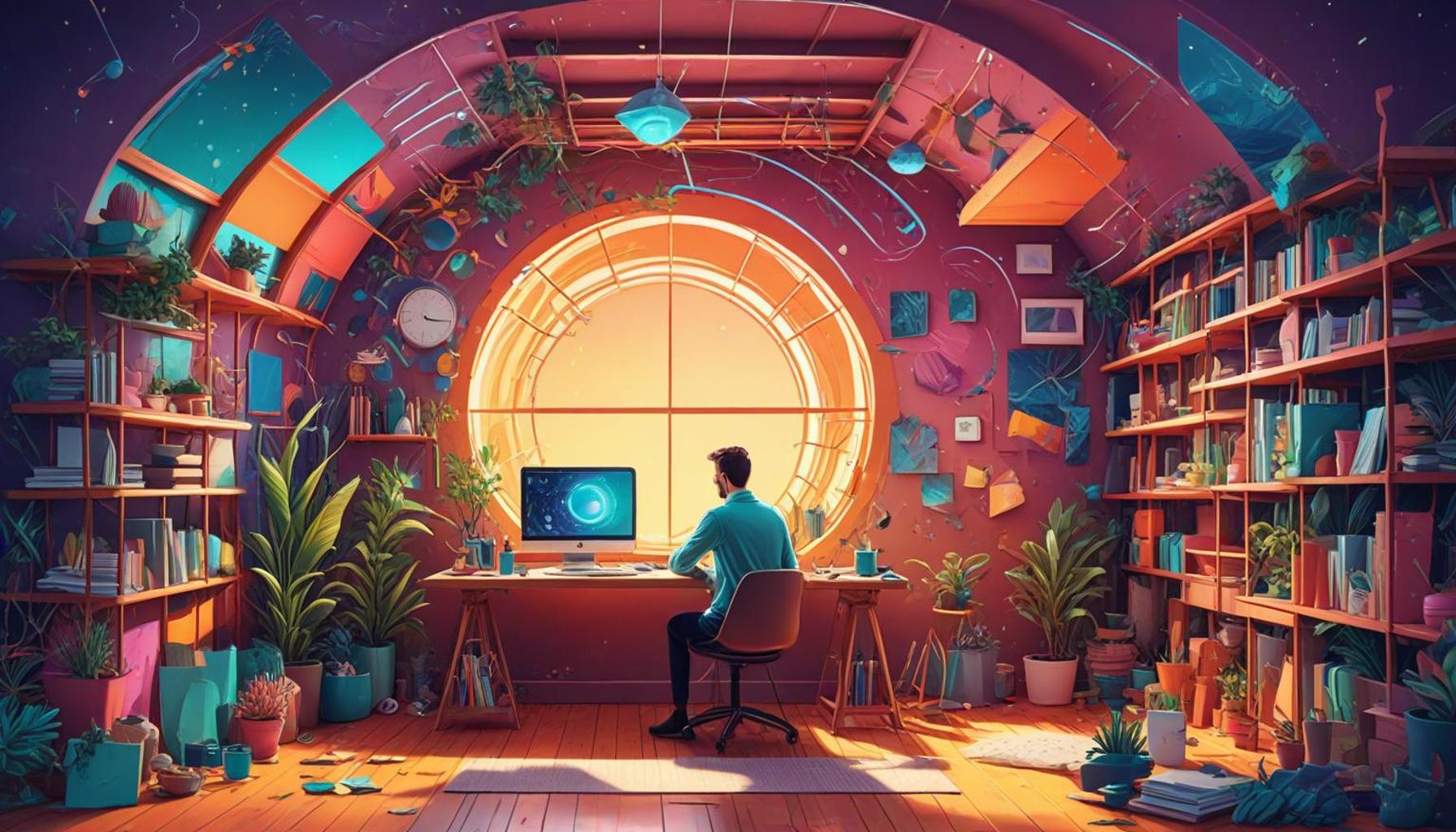The Importance of Spatial Efficiency in Reducing Stress and Increasing Productivity

The Importance of Spatial Efficiency in Modern Workplaces
In today’s fast-paced work environments, the arrangement of physical space has garnered significant attention. How we optimize our surroundings can profoundly affect our mental well-being and overall efficiency. One of the most impactful aspects of workplace design is how well spatial efficiency is implemented to meet the needs of employees.
Spatial efficiency is more than just a buzzword; it’s a critical element of workplace design that directly influences both stress levels and productivity. Research suggests that a well-organized space can lead to various positive outcomes. For instance, many studies indicate that employees working in structured environments display:
- Enhanced focus and concentration: A clutter-free space minimizes distractions, allowing individuals to channel their attention more effectively on tasks.
- Reduced feelings of overwhelm: Simplified layouts help employees feel less stressed, promoting a sense of control over their work environment.
- Improved collaboration among teams: Open spaces designed for teamwork can foster greater communication and synergy among coworkers, enabling innovative problem-solving.
Consider the average office layout—many traditional offices often feature cluttered desks, endless paperwork, and poorly structured workflows. Such elements can create barriers that hinder performance. Conversely, efficient use of space encourages:
- A clearer mindset: Employees are more likely to think creatively in organized and dedicated areas, thus driving innovation.
- Faster task completion: Streamlined processes and easily accessible tools can significantly reduce the time required to complete job tasks.
- Higher job satisfaction: Employees who feel comfortable and supported in their work environment are often more engaged in their roles.
Furthermore, the influence of natural elements like light and plants in the workplace cannot be overlooked. Numerous studies have shown that incorporating green spaces not only beautifies work areas but also dramatically reduces stress levels. For instance, workplaces with ample natural light and plants report higher employee satisfaction and productivity. Innovations like biophilic design—bringing the outdoors in—are gaining traction, revealing just how essential these elements are for emotional and physical well-being.
As we delve deeper into this topic, we will explore how thoughtful design choices can reshape our work experiences, turning them into hubs of creativity and efficiency. By understanding and implementing fundamental principles of spatial efficiency, companies can unlock their employees’ full potential, creating environments that foster growth, happiness, and success.

DISCOVER MORE: Click here to unlock clever organization tips
Understanding the Fundamentals of Spatial Efficiency
To fully appreciate the significance of spatial efficiency, it is essential to grasp its core components and how they interact with employee performance. Efficient spatial design encompasses a range of elements, including layout, organization, and accessibility, all aimed at creating an environment conducive to productivity and mental health. By dissecting these aspects, organizations can gain insights into the best practices for enhancing workplace experiences.
One key principle in spatial efficiency is the concept of layout optimization. A thoughtfully designed floor plan can make a world of difference in how employees navigate their environment. For example, positioning frequently used resources—such as printers, shared meeting rooms, and collaborative spaces—within easy reach can minimize disruptions and allow employees to flow seamlessly between tasks. This strategic placement can lead to a significant reduction in time lost to searching for equipment, ultimately leading to increased productivity.
In addition to layout, the organization of tools and materials is crucial for maintaining an efficient workspace. A cluttered desk or workspace filled with unopened packages and scattered documents can create a chaotic atmosphere. By implementing simple organizational strategies, such as:
- Utilizing storage solutions: Smart use of cabinets, shelves, and filing systems can keep items neatly stored, reducing visual clutter.
- Digitizing documents: Transitioning to digital files can free up physical space and optimize workflows.
- Creating designated zones: Assigning specific areas for different tasks can help employees mentally separate their projects, leading to improved focus.
Effective organization not only creates a visually appealing workspace but also enhances employees’ ability to concentrate on their tasks. When individuals know where everything is and can easily access what they need, they experience considerably lower levels of frustration and distraction, which is essential for stress reduction.
The Psychological Impact of Spatial Efficiency
The psychological impacts of spatial arrangements in the workplace are vast and multifaceted. Studies indicate that when employees are in environments reflecting their needs—such as spaces with adequate privacy for focused work and open areas for collaboration—they report less anxiety and a greater sense of well-being. Engaging with human-centric design principles not only addresses physical aspects but also contributes to an employee’s mental and emotional state, directly correlating to increased productivity.
Furthermore, research conducted by the University of Exeter revealed that environments with effective spatial designs can boost employee productivity by as much as 15%. This statistic underscores the necessity for organizations to regularly reassess their work layouts and practices, ensuring they align with the evolving demands of modern work settings.
As we explore deeper into the importance of spatial efficiency, it becomes increasingly evident that intentional design choices can empower organizations to cultivate environments where creativity flourishes and stress diminishes. By actively investing in spatial efficiency, companies pave the way for heightened performance and enhanced job satisfaction—a win-win for both employers and employees alike.
The Importance of Spatial Efficiency in Reducing Stress and Increasing Productivity
In today’s fast-paced work environment, the significance of spatial efficiency cannot be overstated. When effectively designed, workspaces minimize distractions, enhance focus, and foster a culture of productivity. As companies are striving to adapt to the dynamics of hybrid work models, fostering an atmosphere that promotes collaboration and creativity becomes paramount.
Spatial efficiency extends beyond merely organizing desks and meeting rooms. It encompasses the optimization of every element within a workspace, from lighting to acoustics. For instance, using natural light not only cuts energy costs but also improves mood and cognitive performance, thus reducing stress levels. In fact, research shows that employees working in naturally lit spaces report a 51% reduction in eyestrain and a 63% reduction in headaches.
Beyond aesthetics, functional layouts promote better communication among team members. Open-plan areas, when designed thoughtfully, break down silos and encourage collaboration. Studies indicate that teams working in such environments can be up to 20% more productive compared to those in traditional setups. Furthermore, offering designated quiet zones for focused work helps address the need for concentration in the midst of a bustling office.
As organizations rethink their spatial strategies, incorporating biophilic design—an approach that integrates nature into the workplace—can significantly enhance well-being. Access to plants, water features, and natural materials has been shown to boost employee satisfaction by creating a calming environment, ultimately reflecting on productivity.
Exploring how spatial efficiency is integrated into daily operations can reveal significant insights into optimizing workspaces. As businesses recognize the link between their environment and employee well-being, the potential for increased productivity becomes evident. This evolution not only addresses current challenges but also sets the stage for sustainable growth in an ever-evolving world.
| Category | Benefits |
|---|---|
| Optimized Workspaces | Enhances focus and productivity by reducing distractions. |
| Natural Light | Improves mood, cognitive function, and reduces stress. |
| Collaboration Areas | Encourages teamwork and increases overall productivity by 20%. |
DIVE DEEPER: Click here to discover the emotional benefits of decluttering
Maximizing Collaboration Through Spatial Design
As workplaces evolve, so too does the importance of collaboration among teams. A well-designed workspace can significantly enhance collaborative efforts, promoting creativity and innovative thinking. Open-plan layouts, while sometimes critiqued for potential distractions, can serve as a double-edged sword. Studies indicate that well-thought-out open spaces, complemented by designated quiet zones, can strike a balance between collaboration and individual concentration. For instance, companies such as Google have successfully integrated communal work areas with private pods to give employees the flexibility to choose their optimal work environment, ultimately improving both productivity and comfort.
Organizations should also consider how spatial arrangements affect communication dynamics. When teams are co-located in thoughtfully designed spaces, it fosters spontaneous interactions—a critical component of successful collaboration. Designing common areas, such as lounge spaces or coffee stations, encourages employees to interact outside of formal meetings. These informal settings help reduce barriers between colleagues, ultimately leading to enhanced teamwork and new ideas. A report from Steelcase even identified that 79% of workers prefer to work in teams, illustrating the necessity of supporting collaborative spaces within the workplace.
Emphasizing Comfort and Flexibility
Beyond fostering collaboration, the physical comfort of employees plays a significant role in stress reduction and overall workplace satisfaction. Ergonomic furniture and flexible workstations are not merely trends; they are essential components of spatial efficiency. Proper ergonomics can reduce physical strain, leading to fewer health-related absences and greater employee engagement. Organizations that invest in adjustable desks, supportive seating, and encouraging practices such as standing meetings tend to see major improvements in employee morale and output.
In addition to comfort, creating adaptable spaces facilitates a dynamic work environment that can easily adjust to team sizes and project requirements. For example, modular workspaces allow for quick rearrangement depending on the tasks at hand, providing employees with the autonomy to customize their work areas according to their preferences. A study conducted by the Global Workplace Analytics states that flexible work arrangements bolster employee productivity significantly, as individuals can work in conditions best tailored to their needs.
The Role of Technology in Spatial Efficiency
As the digital transformation continues to penetrate workplaces, the role of technology in enhancing spatial efficiency cannot be overstated. Modern collaborative tools, like virtual whiteboards and video conferencing applications, can connect remote workers to their in-office counterparts, streamlining communication and collaboration regardless of location. Implementing these digital solutions fosters an inclusive environment that supports employees who may not always be present onsite, further broadening the potential for creativity and productivity.
Moreover, leveraging data analytics regarding workspace utilization can inform better spatial designs. Organizations like Microsoft have utilized predictive analytics to understand how employees use their workspaces, leading to informed decisions regarding layout changes and resource allocation. For instance, if data indicates that certain areas are underutilized, businesses can transition those spaces into more productive environments, such as collaborative zones or relaxation areas that cater to employee wellness.
Spatial efficiency stands as a multifaceted approach to enhancing workplace experience, significantly reducing stress while driving productivity. By focusing on collaboration, comfort, and technology integration, organizations can cultivate an environment where employees thrive, unlocking their full potential and innovation capabilities.
DIVE DEEPER: Click here to uncover the emotional benefits of decluttering
Conclusion: The Transformative Power of Spatial Efficiency
In today’s fast-paced work environment, spatial efficiency emerges as a pivotal element influencing employee well-being and productivity. As we have explored, a thoughtfully designed workspace not only minimizes stress but also fosters collaboration, creativity, and comfort. With the rise of modern workplaces, it’s crucial for organizations to recognize the intricacies of spatial design—balancing open areas with quiet zones, promoting informal interactions, and ensuring ergonomic support.
Moreover, as technology continues to reshape our work experiences, the integration of digital tools and data analytics plays a significant role in optimizing spatial arrangements. Businesses that harness these innovations are not only creating adaptable workspaces but also encouraging a culture of productivity that resonates with employees’ diverse needs. The evidence is compelling; environments that prioritize ergonomics and flexibility not only enhance job satisfaction but also drive performance levels. According to studies, employees in optimized workspaces report feeling more engaged and less stressed.
Ultimately, investing in spatial efficiency is not merely a trend but a strategic necessity for organizations aiming to thrive in the competitive landscape. By cultivating spaces that support well-being and collaboration, companies unlock the potential for higher productivity and innovation. As we move forward, it becomes increasingly imperative to embrace the transformative power of spatial efficiency—ushering in an era where workplaces are not just locations for tasks, but vibrant hubs for human connection and creative exploration.



